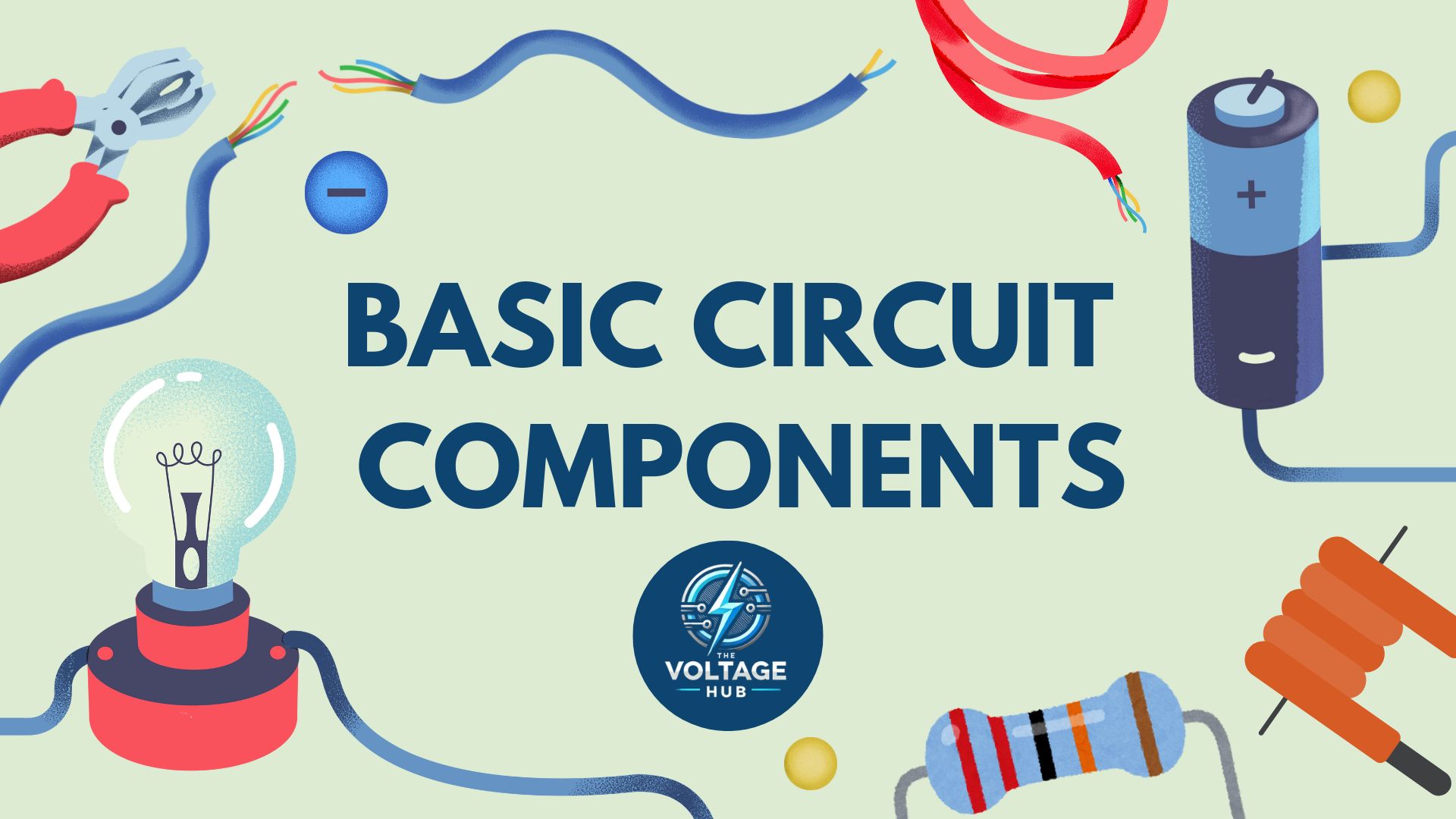Table Of Content
In the realm of electronics and electrical engineering, circuit components serve as the building blocks for designing and constructing functional devices. Whether you’re working on a hobbyist project or advancing to industrial-level applications, understanding the essential components of electrical circuits is key. This article will delve into the details of resistors, capacitors, inductors, diodes, transistors, and power sources—explaining their function, behavior, and applications in the real world.
Introduction to Resistors, Capacitors, and Inductors
1. Resistors
A resistor is one of the most widely used components in electronic circuits. It restricts the flow of electric current and controls the amount of current that passes through a particular part of the circuit. Resistors are essential for controlling voltage levels, protecting components from damage, and adjusting current in sensitive parts of a circuit.
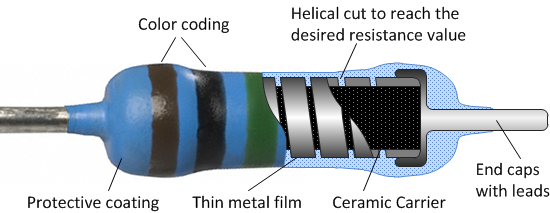
-
Function and Working: The fundamental property of a resistor is its resistance, which is a measure of how much it opposes the flow of current. The relationship between voltage (V), current (I), and resistance (R) is defined by Ohm’s Law, which states:
![]()
This equation is pivotal in determining how resistors affect circuits. A higher resistance results in less current flow for the same voltage, and vice versa.
-
Types of Resistors: There are various types of resistors, including:
- Fixed Resistors: Have a constant resistance value, and are used in applications where the current needs to be controlled precisely.
- Variable Resistors (Potentiometers): The resistance can be adjusted manually to change the current or voltage in a circuit. These are commonly found in volume controls for audio systems.
- Specialty Resistors: For instance, light-dependent resistors (LDRs) change their resistance in response to light, and thermistors change resistance with temperature.
-
Applications: Resistors are used in applications like voltage dividers, current-limiting devices, and in settings where components need to be protected from excessive current.
2. Capacitors
A capacitor is an essential component that stores and releases electrical energy in the form of an electric field. When connected to a circuit, capacitors are used to smooth fluctuations in voltage, filter signals, and temporarily store energy for later use.
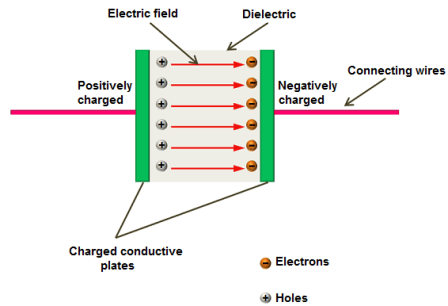
- Function and Working: Capacitors consist of two conductive plates separated by an insulating material called a dielectric. When voltage is applied to the capacitor, an electric field forms between the plates, storing charge. The capacitance (measured in farads, F) indicates the capacitor’s ability to store charge. The larger the capacitance, the more charge a capacitor can store for a given voltage.The relationship between voltage (V), charge (Q), and capacitance (C) is given by the equation:
![]()
Where Q is the charge, C is the capacitance, and V is the voltage across the plates.
- Types of Capacitors: Capacitors come in various forms, such as:
- Ceramic Capacitors: Often used for small, low-voltage applications like signal filtering.
- Electrolytic Capacitors: Known for their large capacitance values, these are commonly used in power supply filtering.
- Tantalum Capacitors: A type of electrolytic capacitor that is known for its stability and reliability in critical applications.
- Applications: Capacitors are used in power supply circuits to smooth DC output, in filtering circuits to block DC while allowing AC signals to pass, and for signal coupling in communication devices.
3. Inductors:
An inductor is a passive electronic component that stores energy in a magnetic field when electrical current flows through it. Inductors oppose changes in current, a phenomenon known as inductive reactance.
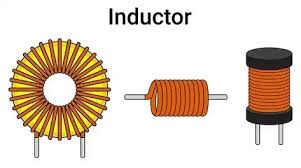
- Function and Working: When current flows through an inductor, it creates a magnetic field around it. If the current changes, the magnetic field also changes, inducing a voltage in the opposite direction of the current change, thereby opposing the change. This property is governed by Faraday’s Law of Induction.The relationship between voltage (V), current (I), and inductance (L) in an inductor is expressed as:
Where V is the voltage, L is the inductance in Henries (H), and ![]()
is the rate of change of current.
- Types of Inductors:
- Air-core Inductors: Do not have a magnetic core and are often used in high-frequency applications.
- Iron-core Inductors: Use a magnetic core to increase inductance, often used in power supplies and transformers.
- Toroidal Inductors: Have a donut-shaped core and are used for reducing electromagnetic interference.
- Applications: Inductors are used in filters, transformers, and chokes to control the flow of current and to block certain frequencies in electronic circuits.
The Role of Diodes and Transistors in Circuits
4. Diodes
A diode is a semiconductor device that allows current to flow in only one direction—acting as a one-way valve for electrical current. Diodes are made from materials like silicon or germanium, and they have two terminals: the anode and the cathode
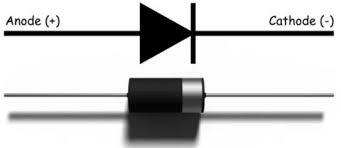 .
.
- Function and Working: When the anode is positive relative to the cathode, the diode is forward-biased and allows current to pass. When the cathode is positive relative to the anode, the diode is reverse-biased and prevents current from flowing.
- Types of Diodes:
- Standard Diodes: Used for rectification, converting AC to DC.
- Zener Diodes: Allow current to flow in both directions but can also operate in reverse-bias to maintain a constant voltage, making them ideal for voltage regulation.
- Light-Emitting Diodes (LEDs): Emit light when forward-biased and are widely used for displays and indicators.
- Applications: Diodes are used in rectifiers (AC to DC conversion), voltage regulation, protection circuits, and signal processing.
5. Transistors
A transistor is a semiconductor device used to amplify or switch electronic signals. It is the fundamental building block of modern electronic devices and is responsible for enabling functions like amplification, switching, and digital logic.
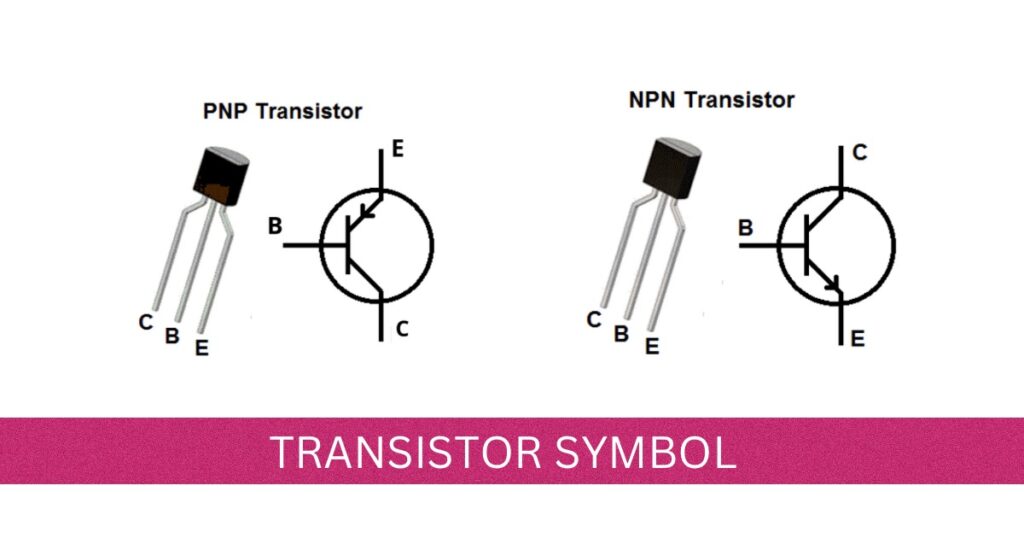
- Function and Working: A transistor typically has three layers of semiconductor material, known as the emitter, base, and collector. In a bipolar junction transistor (BJT), a small current applied to the base controls a much larger current flowing between the collector and emitter. In field-effect transistors (FETs), the base voltage controls the flow of current by creating an electric field.
- Types of Transistors:
- NPN and PNP BJTs: Differ based on the arrangement of the semiconductor layers and how they are biased.
- Field-Effect Transistors (FETs): Includes Junction FETs (JFETs) and Metal-Oxide-Semiconductor FETs (MOSFETs), which are more commonly used in modern digital electronics.
- Applications: Transistors are used in amplifiers (audio, radio, etc.), logic gates, microprocessors, and as switches in digital circuits.
Understanding Batteries and Power Sources
6. Batteries:
Batteries are crucial for providing electrical energy to circuits, especially in portable devices like smartphones, laptops, and electronic toys. A battery stores chemical energy, which is converted to electrical energy when a circuit is completed.
- Function and Working: A typical battery contains one or more electrochemical cells, each with two electrodes (an anode and a cathode) and an electrolyte that facilitates ion movement between the electrodes. As a battery discharges, a chemical reaction at the electrodes releases electrons, creating a current.
- Types of Batteries:
- Alkaline Batteries: Common in household devices, offering a reliable source of power for low-drain devices.
- Lithium-Ion Batteries: Used in portable electronics due to their high energy density and rechargeability.
- Lead-Acid Batteries: Often used in vehicles and backup power systems for their high current capabilities.
- Applications: Batteries are used in almost every mobile electronic device, as well as in electric vehicles and renewable energy storage.
7. Power Supplies:
A power supply is a device that converts electrical energy from one form to another, typically from alternating current (AC) to direct current (DC), and regulates the voltage and current supplied to a circuit.
- Function and Working: Power supplies take in AC from the grid and convert it to a stable DC output using rectifiers and voltage regulators. The power supply ensures that sensitive components within a circuit receive the correct voltage and current.
- Types of Power Supplies:
- AC-DC Converters: Convert the AC from wall outlets into DC for powering devices like computers, televisions, and radios.
- DC-DC Converters: Change one DC voltage level to another, useful in applications requiring a different voltage than the input.
- Linear and Switching Regulators: Regulate output voltage, with linear regulators being simpler but less efficient than switching regulators.
- Applications: Power supplies are used in computers, communication equipment, audio systems, and other electronic devices that require a stable and controlled power input.
Conclusion
Mastering the roles and functions of basic circuit components is essential for anyone involved in electronics or electrical engineering. Resistors, capacitors, inductors, diodes, transistors, and power sources each serve unique purposes, from controlling current and voltage to amplifying signals and powering devices. Whether you’re designing a simple circuit or working with advanced systems, understanding these components will provide you with the knowledge to create reliable and effective electronic solutions.

